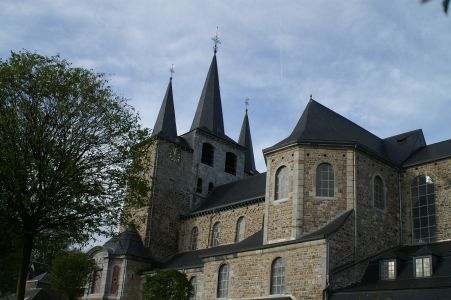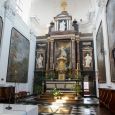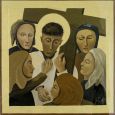Collegiate Church | 1089 | Romanesque | Catholic Church



Map
Opening hours
01 April - 30 September
Mon -
Tue -
Wed 14.00 - 17.00
Thu -
Fri -
Sat 11.00 - 17.00
Sun 14.00 - 17.00
You can also contact the Tourist Office, just opposite the collegiate church: +32 85 31 44 48
Guided tour
Religious offices
Description
The building of Romanesque origin was built in the 11th century but underwent many transformations. The major works of the 18th century will give the church its current architectural aspect. The harsh nature of the origins has given way to a coherent and embellished profile.
The church houses two Treasures recognised as part of the Wallonia-Brussels Federation's heritage: the superb Merovingian sarcophagus of Saint Chrodoara, which can be admired through a large glass opening in the choir, where it was discovered on 22 January 1977, and the shrine of Saint Ode, a masterpiece of 13th century Mosan goldsmithery.
This church is classified as an exceptional heritage site in Wallonia. It was completely restored between 1998 and 2001.
Photos
Media
Remarkable elements
Sarcophagus of sancta Chrodoara
The exceptional Merovingian sarcophagus of sancta Chrodoara, probably from the 8th century, highlights undeniable artistic qualities. It was found in 1977 in the foundations of the collegiate church. We can see a woman holding in her right hand a stick (cane and/or badge of an abbey power?), while a Latin inscription, carved into the stone, gives glory to sancta Chrodoara, "noble, great and illustrious, who enriches sanctuaries with his own goods". Chrodoara was venerated under the name of Saint Ode from the 11th century onwards.
Shrine of Saint Ode
Magnificent example of the different techniques of Mosan goldsmithing of the 13th century. The shrine consists of an oak core covered with copper, silver, enamel and stone slabs. Tradition has it that Chrodoara married the Duke of Aquitaine. When she became a widow in 589, she would have left the region to settle in Amay where she would have devoted her time and fortune to the Church and charity. She was buried under Amay's church. Later, at the beginning of the 8th century, Floribert, Bishop of Liege, reportedly translated the relics in the sarcophagus. Around 1235, the relics were transferred to this shrine. Since 2017, the shrine has been enhanced in the former chapter house.
Monumental paintings of Fisen and Juppin
Four large paintings evoking episodes of the life of Christ hang on the walls of the choir. They are the work of two 18th century artists. The landscapes were painted by Jean-Baptiste Juppin (Namur, 1675 - 1729), while the characters were made by Englebert Fisen (Liège, 1655 - 1733), a very productive painter from Liège, a student of Bertholet Flémal.
Cloister
The splendid eastern cloister (there are only seven in Western and Central Europe), probably of Romanesque origin and restored in the 18th century, houses the municipal museum which displays the archaeological finds discovered during the excavations of the Hesbaye-Condroz archaeological circle.
Way of the Cross
Magnificent contemporary work by the Amaytois artist Georges Leplat (1930-2010), Way of the Cross with 15 stations made with gold leaf using the iconic technique. Enhancing the building's interior radiance, her works enrich the collegiate's precious collection of works of art.
Religious art
The collegiate church also houses a remarkable collection of christs, furniture representative of the stylistic evolution from the 17th to the 19th centuries, the paintings of Fisen "Charité de sainte Ode" at the end of the 17th century and Deprez "Sainte Ode et le mendiant" from 1772, many statues from the early 16th to the 20th century, liturgical ornaments, superb rood house of 1685, statues of the patron saints of the high altar (late 17th century), the Clerinx organ of 1866; three bas-reliefs by Antoine-Marin Mélotte retracing the episodes of the life of Saint Barbe; in the treasury, religious silverware, missals, antique antiphonaries etc...


























